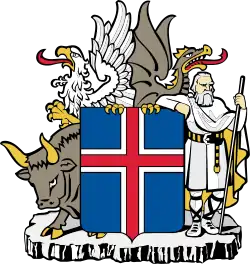Egilsstaðir | |
|---|---|
Town | |
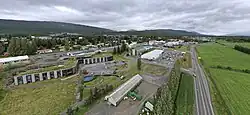 2023 view of Egilsstaðir | |
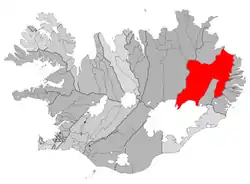 Location of the Municipality of Múlaþing | |
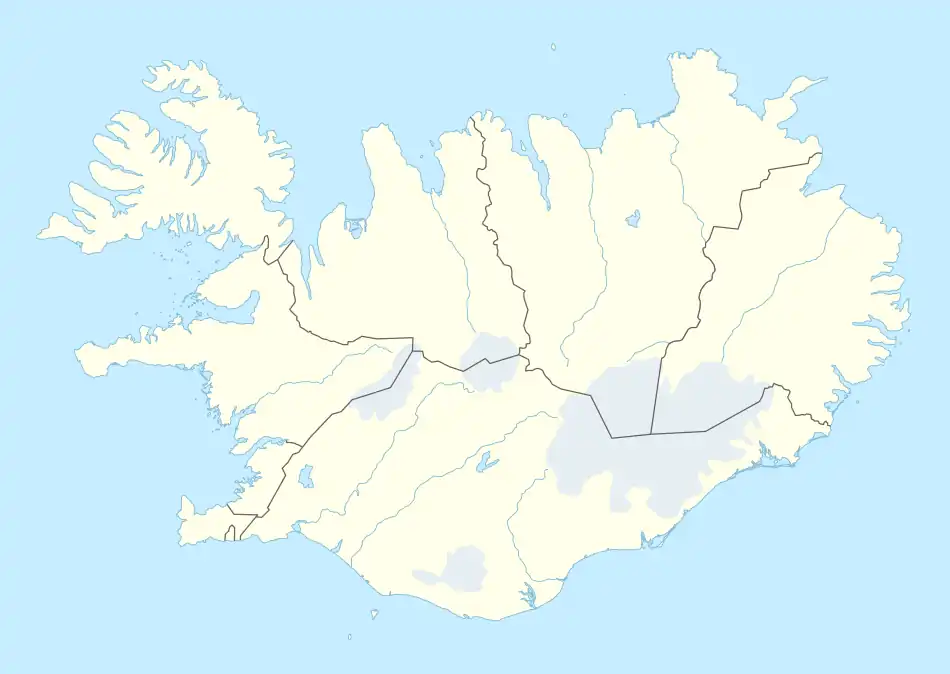 Egilsstaðir Location in Iceland | |
| Coordinates: 65°17′N 14°23′W / 65.283°N 14.383°W | |
| Country | |
| Constituency | Northeast Constituency |
| Region | Eastern Region |
| Municipality | Múlaþing |
| Population (2022) | |
| • Town | 2,572 |
| • Metro | 2,955[a] |
| Time zone | UTC+0 (GMT) |
| Postal code(s) | 700, 701 |
| Website | www |
| ^a including Fellabær | |
Egilsstaðir (Icelandic pronunciation: [ˈeijɪlsˌstaːðɪr̥]) is a town in east Iceland on the banks of the Lagarfljót river.
It is part of the municipality of Múlaþing and the largest settlement of the Eastern Region with, as of 2020, a population of 2,522 inhabitants. Formerly Egilsstaðir was part of Norður-Múlasýsla.
Overview
Egilsstadir is located at 65°17′N 14°23′W / 65.283°N 14.383°W. The town is young, even by Icelandic standards where urbanization is a fairly recent trend compared to mainland Europe. It was established in 1947 as an effort by the surrounding rural districts recognizing it had become a regional service centre. The town takes name from an individual farmstead and is in this respect relatively unique within the country where most or all of the towns take name from broader landmarks. It is near the bridge over Lagarfljót where all the main roads of the region meet, Route 1 as well as the main routes to the Eastern Region.
Egilsstaðir has grown to become the largest town of East Iceland and its main service, transportation, and administration centre. The town has an airport, college, and a hospital. The town grew quickly during the economic boom in the region from 2004 to 2008 associated with the building of the Kárahnjúkar Hydropower Plant and Alcoa's aluminium smelting plant in Reyðarfjörður. The growth has slowed markedly since the banking collapse in 2008.
History
In written accounts, Egilsstaðir is first mentioned in the 15th century as a place for legislative assembly. Nothing is therefore known with certainty about the individual person Egil lending it its name, the only conjecture to this effect met with in books detailing the story of the town is that it may be named after Egil Síðu-Hallsson, but Hallr at Síða was a captain in the east and an uncle to Rollo in France, but this guess is of controlled probability and most likely the person left no other recort of himself. The nearby river Eyvindará is mentioned in the Saga of the Sons of Droplaug and Saga of the inhabitants of Fljótsdalur.
Urbanization in Egilsstaðir can be traced to Jón Bergsson (1855–1923), a farmer, who laid the groundwork for increased commerce and services at the Egilsstaðir farm by erecting a large residential building there at the start of the 20th century. The house is still in use as a hotel. Jón bought the farm Egilsstaðr at the close of the 19th century because of its location when he predicted "Crossroads will be here", which proved prescient.[1] Along with others, Jón Bergsson also took the initiative to establish the co-operative Kaupfélag Héraðsbúa (KHB) with headquarters there in 1909.[2] [3] In subsequent years, bridges were built over Lagarfljót river and Eyvindará river and a road made over Fagridalur to Reyðarfjörður. Later, the regional headquarters for mail and telephone services were located at Egilsstaðir.[4]
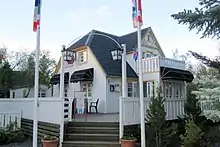
In 1947 Egilsstaðir was incorporated as a town and a rural jurisdiction Egilsstaðahreppur, with neighbouring jurisdictions Vallahreppur and Eiðahreppur joining the new jurisdiction. The town soon grew and by 1980 the population exceeded 1000. In 1987, the status of the town was upgraded to kaupstaður and renamed Egilsstaðabær, or the town of Egilsstaðir. In early 2011, the population was 2,257 and had increased by 41 percent from 2001, when 1,600 were registered there.[5]
On 7 June 1998 Egilsstaðabær was united with Vallahreppur, Skriðdalshreppur, Eiðahreppur and Hjaltastaðarhreppur under the name Austur-Hérað. Austur-Hérað then became Fljótsdalshérað in 2004. In 2020 it joined other municipalities to form Múlaþing.
Climate
Depending on isotherm Egilsstaðir has a subarctic climate (Köppen: Dfc) or a subpolar oceanic climate (Cfc) bordering very closely on a Tundra climate (ET). Winters there tend to be colder than other towns in the area, and summers tend to have daytime highs often exceeding 15 °C (59 °F), higher than most of Iceland, but at night it is colder than most towns with a similar climate. The town being at a relatively low elevation somewhat shielded from maritime winds enables warmer air to stay for longer than in coastal areas, although the effect of southerlies become negated by high mountains blocking such winds, and as a result Egilsstaðir still has a lot cooler summers than continental Nordic climates have on similar latitudes. Egilsstaðir being relatively close to the east coast also increased the maritime moderation both in summer and winter. With Central Iceland being at a highland tundra, the Egilsstaðir area is still the warmest for 1961–1990 summer maxima among Icelandic weather stations for populated areas.
The figures here given for precipitation days and sunshine hours belong to Grímsárvirkjun and Hallormsstaður, which are 15 kilometres (9 mi) and 25 kilometres (16 mi) away from Egilsstaðir respectively and get around 100 millimetres (4 in) more precipitation than Egilsstaðir, so it is possible that Egilsstaðir has fewer days with precipitation and gets more sunlight than stated below. The highest temperature recorded is 29.2 °C (84.6 °F) on 11 August 2004, recorded at Egilsstaðir Airport.[6]
| Climate data for Egilsstaðir (1961–1990) | |||||||||||||
|---|---|---|---|---|---|---|---|---|---|---|---|---|---|
| Month | Jan | Feb | Mar | Apr | May | Jun | Jul | Aug | Sep | Oct | Nov | Dec | Year |
| Record high °C (°F) | 14.2 (57.6) |
12.5 (54.5) |
14.5 (58.1) |
18.5 (65.3) |
25.0 (77.0) |
26.7 (80.1) |
28.8 (83.8) |
29.2 (84.6) |
21.9 (71.4) |
18.9 (66.0) |
13.8 (56.8) |
14.0 (57.2) |
29.2 (84.6) |
| Mean daily maximum °C (°F) | 0.7 (33.3) |
1.4 (34.5) |
2.2 (36.0) |
5.0 (41.0) |
8.9 (48.0) |
13.1 (55.6) |
14.8 (58.6) |
13.9 (57.0) |
10.0 (50.0) |
6.0 (42.8) |
2.3 (36.1) |
1.2 (34.2) |
6.6 (43.9) |
| Daily mean °C (°F) | −2.4 (27.7) |
−1.9 (28.6) |
−1.4 (29.5) |
1.2 (34.2) |
4.8 (40.6) |
8.7 (47.7) |
10.3 (50.5) |
9.6 (49.3) |
6.2 (43.2) |
3.1 (37.6) |
−0.7 (30.7) |
−2.2 (28.0) |
2.9 (37.3) |
| Mean daily minimum °C (°F) | −5.8 (21.6) |
−5.3 (22.5) |
−4.4 (24.1) |
−2.0 (28.4) |
1.4 (34.5) |
5.0 (41.0) |
6.6 (43.9) |
6.2 (43.2) |
3.2 (37.8) |
0.4 (32.7) |
−3.8 (25.2) |
−5.3 (22.5) |
−0.3 (31.5) |
| Record low °C (°F) | −24.0 (−11.2) |
−22.1 (−7.8) |
−26.7 (−16.1) |
−21.4 (−6.5) |
−10.8 (12.6) |
−4.5 (23.9) |
−0.5 (31.1) |
−2.7 (27.1) |
−6.8 (19.8) |
−14.4 (6.1) |
−19.4 (−2.9) |
−22.5 (−8.5) |
−26.7 (−16.1) |
| Average precipitation mm (inches) | 70.5 (2.78) |
50.3 (1.98) |
62.0 (2.44) |
39.5 (1.56) |
27.8 (1.09) |
27.6 (1.09) |
39.8 (1.57) |
41.4 (1.63) |
67.7 (2.67) |
76.5 (3.01) |
54.9 (2.16) |
60.6 (2.39) |
618.6 (24.37) |
| Average precipitation days (≥ 0.1 mm) | 14.7 | 11.9 | 13.6 | 10.4 | 9.4 | 10.1 | 11.6 | 12.5 | 13.7 | 14.5 | 13.1 | 14.0 | 149.5 |
| Average relative humidity (%) | 83 | 82 | 82 | 79 | 78 | 75 | 79 | 80 | 81 | 83 | 83 | 83 | 81 |
| Mean monthly sunshine hours | 0.6 | 33.5 | 84.2 | 142.5 | 182.4 | 187.3 | 172.9 | 145.7 | 86.1 | 46.2 | 6.4 | 0 | 1,087.8 |
| Source 1: Icelandic Met Office (extremes 1955–97, humidity 1963–90, sun 1960–89 for Hallormsstaður-25 km (15 mi) from Egilsstaðir)[7][8] | |||||||||||||
| Source 2: Icelandic Met Office (precipitation days 1961–90 for Grímsárvirkjun-15 km (9 mi) from Egilsstaðir)[9] | |||||||||||||
The climate has significantly warmed in recent years, as seen in the climate averages for the 1991–2020 reference period.
| Climate data for Egilsstaðir (1991–2020) | |||||||||||||
|---|---|---|---|---|---|---|---|---|---|---|---|---|---|
| Month | Jan | Feb | Mar | Apr | May | Jun | Jul | Aug | Sep | Oct | Nov | Dec | Year |
| Daily mean °C (°F) | −0.9 (30.4) |
−1.0 (30.2) |
−0.3 (31.5) |
2.0 (35.6) |
5.5 (41.9) |
9.5 (49.1) |
10.7 (51.3) |
10.4 (50.7) |
7.8 (46.0) |
3.7 (38.7) |
0.6 (33.1) |
−1.1 (30.0) |
3.8 (38.8) |
| Source: Icelandic Met Office[10] | |||||||||||||
Points of interest
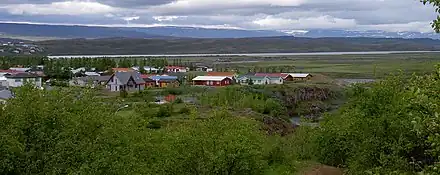
- Eiðar longwave transmitter
- Kárahnjúkar Hydropower Plant
- Hallormsstaðaskógur – the biggest forest in Iceland
- Hengifoss – a waterfall in Fljótsdalur
- Skriðuklaustur – the mansion of writer Gunnar Gunnarsson
- Öxi – mountain road between Egilsstaðir and Djúpivogur
Notable natives
- Sveinn Birkir Björnsson – former editor of the Reykjavík Grapevine
- Sigmar Vilhjálmsson – Iceland TV host
- Hjálmar Jónsson – Iceland national team footballer
- Vilhjálmur Einarsson, triple-jump athlete, silver medal winner at the 1956 Olympic games
- Magnús Ver Magnússon, four times World's Strongest Man (1991, 1994, 1995, and 1996)
References
- ↑ "Um sögu Egilsstaðabæjar" (in Icelandic). Retrieved 30 May 2011.
- ↑ "Pöntunarfjelag Fljótsdalshéraðs" (in Icelandic). Retrieved 30 May 2011.
- ↑ "Austur-Hérað" (in Icelandic). Retrieved 30 May 2011.
- ↑ "Austri, 17. janúar 1903, 13. árg., 2. tbl" (in Icelandic). Archived from the original on 26 July 2011. Retrieved 30 May 2011.
- ↑ "Hagstofa Íslands, mannfjöldi" (in Icelandic). Retrieved 30 May 2011.
- ↑ "Hæsti hiti á Íslandi – Teigarhorn 22. júní 1939". Icelandic Meteorological Office. Retrieved 11 February 2017.
- ↑ "Climatological Data for Egilsstaðir". Icelandic Meteorological Office. Retrieved 19 November 2016.
- ↑ "Climatological Data for Hallormsstaður". Icelandic Meteorological Office. Retrieved 19 November 2016.
- ↑ "1961–90 Precipitation Averages for Grímsárvirkjun". Icelandic Meteorological Office. Retrieved 19 November 2016.
- ↑ "Fréttir". Icelandic Meteorological Office. Retrieved 11 August 2022.
External links
 Media related to Egilsstaðir at Wikimedia Commons
Media related to Egilsstaðir at Wikimedia Commons Egilsstaðir travel guide from Wikivoyage
Egilsstaðir travel guide from Wikivoyage
